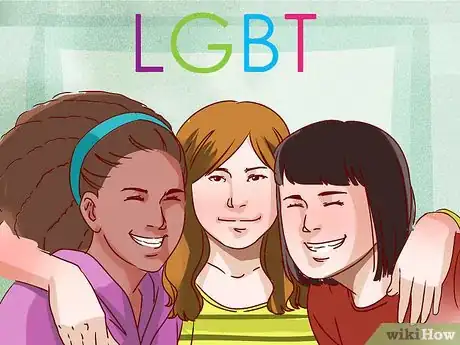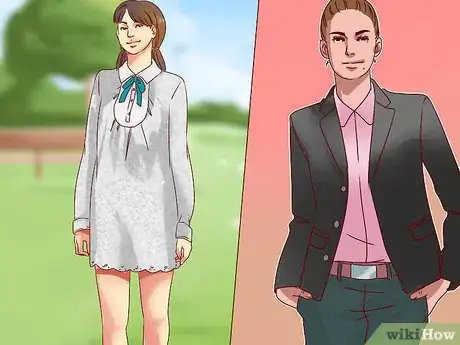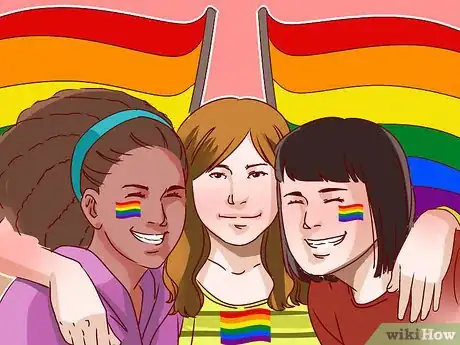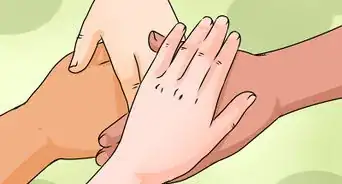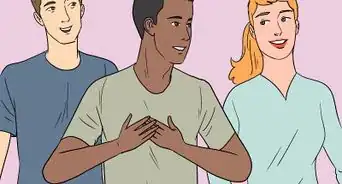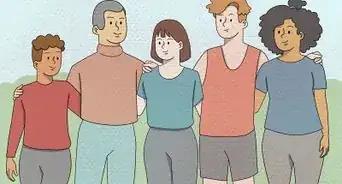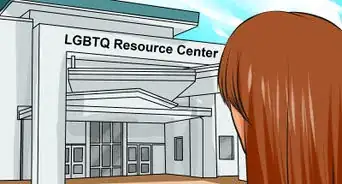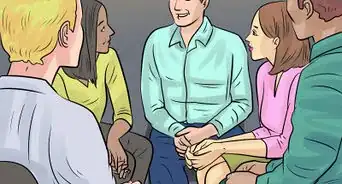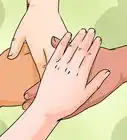This article was co-authored by Marissa Floro, PhD. Dr. Marissa Floro, Ph.D. is a Psychologist and Instructor at Stanford University’s Weiland Health Initiative and adjunct faculty at the University of San Francisco. Dr. Floro received her Ph.D. in Counseling Psychology from Loyola University Chicago, focusing on the intersections of race, attraction, and gender. Dr. Floro’s continued clinical, teaching, and advocacy work focuses on sexual and gender diversity, racial identity and belonging, and liberation from oppressive systems and structures.
There are 12 references cited in this article, which can be found at the bottom of the page.
wikiHow marks an article as reader-approved once it receives enough positive feedback. In this case, 100% of readers who voted found the article helpful, earning it our reader-approved status.
This article has been viewed 79,524 times.
Developing lesbian pride is a journey. You can start small by learning more about your new community and joining organizations. Once you've explored your identity more and gotten more comfortable, you can speak out when people say hurtful things about lesbians. From there, you can become more of an activist to educate and encourage others to stand up for LGBTQ+ rights. Taking pride in being a lesbian also means finding self-acceptance and coming out to others.
Steps
Accepting Yourself as a Lesbian
-
1Overcome feelings of fear, shame, and rejection. Once you’ve discovered your identity, it’s common to have difficulty fully accepting it because of feelings of fear and shame. You may worry you’re not going to be accepted by your peers or family members. You may start to feel isolated from others.
- If your family, culture, and/or religion is against LGBTQ+ identities, you might have more difficulty with feelings of fear, shame, and denial.
- At this stage, it’s normal for you to compartmentalize your sexual identity or to feel like being a lesbian may not be permanent.
-
2Explore and accept your identity. To move past the negative feelings of shame and isolation, explore more about what it means to be a lesbian. Seek out and connect to other lesbians. Find out more about LGBT culture.
- If you are a university student, most campuses have a LGBTQ+ resource center, where you can find information, community resources, cultural events, and supportive people.
- If you are teenager, and have a family and school that is accepting of LGBTQ+ identities, consider connecting with resources in your school, such as your guidance counselor or other students.
- If you are a teenager and don’t feel safe going to anyone in your community, find online resources from The Trevor Project. They have online resources about sexual orientation and the coming out process, as well as a safe space for you to chat with others online for more information. They also have a hotline you can call 24 hours a day, 7 days a week.[1]
Advertisement -
3Share your identity with others. Once you’ve accepted who you are, it’s time to share that with others. Choose who to come out to and when you want to tell them. You do not have to come out to everyone at once, and some people choose to come out only to their friends and family, but not at work.[2]
- Choose someone who is supportive of you to be the first person you come out to.
- Prepare yourself for negative reactions and rejection. Unfortunately, some people may not be accepting of you. Don’t give up hope, they may just need time to adjust.[3]
- Know that it is your choice to disclose your identity or not.[4] [5]
- If you choose to come out, think about why you want to do so. Is it because you want to connect with the person romantically or sexually, or do you want support from them.[6]
- You should have a safety plan in place. For example, if things get worse, you should have a place to stay, a trustworthy person to support you, and money to meet your needs.[7] [8]
Discovering Pride
-
1Meet other lesbians. Begin immersing yourself in the lesbian community more. Find out about lesbian subculture, values, and organizations. Find LGBTQ-friendly churches and businesses. Look for festivals, events, and support groups for lesbians in your community. Consider joining or following the news of these organizations:
-
2Follow lesbian role models on social media. Having lesbian role models you can look to helps affirm you can be who you are. Seeing these women and their success will give you a sense of pride and hope. Consider paying attention to people like:
- Ellen DeGeneres
- Rachel Maddow
-
3Start small. Before you become an activist, start with small ways to show your pride. You can do simple things like:
- Fly a pride (rainbow) or lesbian flag.
- Put the Human Rights Campaign logo on your car.
- Watch television shows that affirm lesbians, such as "Orange is the New Black."
-
4Be out. Be open and authentic in public. Don't be afraid to hold hands or kiss your partner or girlfriend in public. Don't feel the need to hide the fact that you're dating a woman.
- Use caution and know where it's safe to show your pride.
- Every time you meet someone new at work or in your community, share your story, or advocate for LGBTQ+ rights and equality, you're continually coming out. You’ve likely helped someone else who is struggling with their identity.[11]
Strengthening Pride
-
1Confront lesbian stereotypes. There are many stereotypes about lesbians such as if you're a lesbian, you must look "butch" or dress more like a man. This isn't necessarily true. Celebrate lesbians of all shapes, sizes, and styles.[12]
-
2Learn as much as you can. It takes time to become an expert on any subject, even if you have had personal life experiences with that subject. People are more likely to listen to you and respect your point of view if you are willing to learn from their perspectives. This may include the views of other people in the LGBTQ community. Listen to other people’s perspectives and personal experiences, and find research and data from reputable sources to keep learning more.
-
3Speak up. When others say discriminating things like "dyke," the f slur or the term "that's so gay," explain what words are okay to use for the LGBTQ+ population. Educate and encourage others, heterosexual people especially, to become allies. Challenge heterosexual people to examine their privilege, gender roles, and sexuality.[13]
-
4Be an activist. Commit to being a part of social change so that you can have a positive impact through education and advocacy. Advocate for lesbian and gay rights. You can do this by:[14]
- Going to rallies and demonstrations.
- Participating in LGBTQ+ Pride parades and celebrations.
- Joining and advocating on behalf of CenterLink, a network of LGBT Community Centers.[15]
- Ensuring your employers recognize same-sex partners in your health plan.
- Visiting your representatives in Congress and educating them on the needs of the LGBTQ+ population.
- Protesting in other areas in the world where LGBTQ+ people face discrimination.
-
5Celebrate. Recognize the struggles, challenges, and discrimination you've faced because you’re a lesbian. It’s not always been easy for you, but it’s allowed you to develop strength in the face of adversity. Take time to celebrate your greater self-confidence, pride, and increased empathy for others.
-
6Integrate your identity. Sexual orientation is only one part of who you are. Increase your time spent in other communities and cultures, not just lesbian-oriented, and be comfortable being a lesbian in these other spaces. Allow yourself to build trust, communication, relationships, and connection with others who are not lesbians. Continue to educate them and be proud of who you are.
Expert Q&A
-
QuestionYou suggested becoming active in your community, but what happens if I'm the only LGBTQ+ person, since I live in Asia and I go to a christian school? What should I do?
 Trudi Griffin, LPC, MSTrudi Griffin is a Licensed Professional Counselor in Wisconsin specializing in Addictions and Mental Health. She provides therapy to people who struggle with addictions, mental health, and trauma in community health settings and private practice. She received her MS in Clinical Mental Health Counseling from Marquette University in 2011.
Trudi Griffin, LPC, MSTrudi Griffin is a Licensed Professional Counselor in Wisconsin specializing in Addictions and Mental Health. She provides therapy to people who struggle with addictions, mental health, and trauma in community health settings and private practice. She received her MS in Clinical Mental Health Counseling from Marquette University in 2011.
Professional Counselor There are online sources for support and advocacy groups that may offer you opportunities to connect with others.
There are online sources for support and advocacy groups that may offer you opportunities to connect with others.
Warnings
- Other people may be angry or reject you for being a lesbian. Your safety is most important. Surround yourself with others who you trust in your community.⧼thumbs_response⧽
References
- ↑ https://www.thetrevorproject.org/
- ↑ https://www.washington.edu/counseling/resources/resources-for-students/thinking-of-coming-out/
- ↑ https://www.washington.edu/counseling/resources/resources-for-students/thinking-of-coming-out/
- ↑ https://kidshealth.org/en/teens/coming-out.html
- ↑ Marissa Floro, PhD. Counseling Psychologist. Expert Interview. 18 February 2021.
- ↑ Marissa Floro, PhD. Counseling Psychologist. Expert Interview. 18 February 2021.
- ↑ https://www.teenvogue.com/story/how-to-come-out-to-parents-tips
- ↑ Marissa Floro, PhD. Counseling Psychologist. Expert Interview. 18 February 2021.
- ↑ http://www.nclrights.org/
- ↑ https://gsanetwork.org/about-us
- ↑ https://www.theguardian.com/technology/2014/oct/30/apple-chief-tim-cook-proud-to-be-gay
- ↑ http://www.telegraph.co.uk/women/womens-life/10452313/Young-lesbians-where-are-they-all-Coming-out-in-an-era-of-lesbophobia.html
- ↑ http://www.amnestyusa.org/pdfs/Ally_Toolkit.pdf
- ↑ http://www.uua.org/lgbtq/witness/25356.shtml
- ↑ http://www.lgbtcenters.org/Centers/find-a-center.aspx




